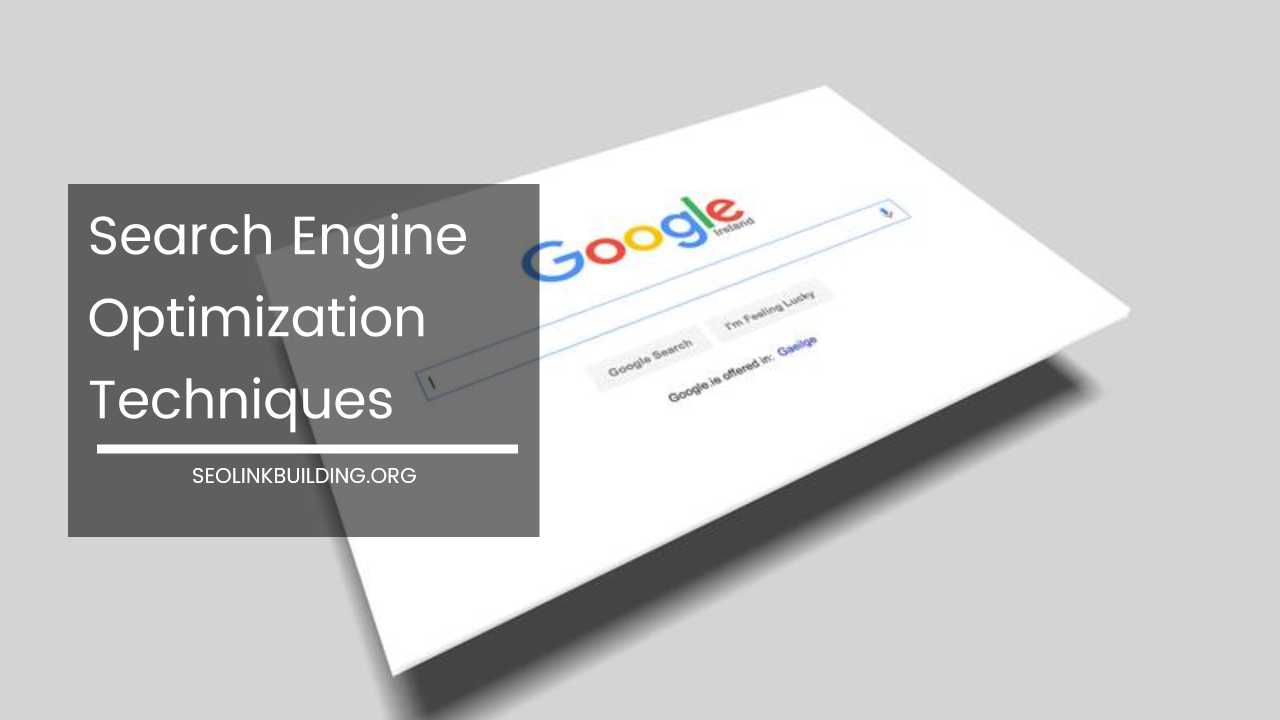Ultimate SEO Checklist: Search Engine Optimization Techniques

Mastering the Search Engine Game: Powerful SEO Techniques to Boost Your Website Traffic
In today’s digital age, a website without a strong SEO foundation is like a lone whisper in a crowded marketplace. Search Engine Optimization (SEO) is the art and science of optimizing your website to rank higher in search engine results pages (SERPs) for relevant keywords.
The higher you rank, the more organic traffic you attract, translating to increased brand awareness, leads, and conversions.
This comprehensive guide delves deep into powerful SEO techniques that will propel you up the SERP ladder and secure top rankings.
We’ll explore everything from on-page optimization to advanced link-building strategies, ensuring your website becomes a magnet for your target audience.
Demystifying Search Engine Algorithms: What Makes Your Website Tick?
Search engines like Google utilize complex algorithms to determine which websites deserve the coveted top spots. While the exact workings remain a closely guarded secret, we do know that these algorithms consider various factors:
- Content Relevance: Does your content directly address the user’s search intent and provide valuable, informative answers to their queries?
- On-Page Optimization: Are your title tags, meta descriptions, headings, and body content strategically optimized with relevant keywords?
- Technical SEO: Is your website mobile-friendly, lightning-fast, and secure?
- Backlink Profile: How many websites link back to yours, and what’s the authority and relevance of those linking websites?
- User Experience (UX): Does your website offer a positive experience for visitors with clear navigation, easy readability, and fast loading times?
On-Page Optimization: The Bedrock of SEO Success
On-page optimization refers to the art of fine-tuning the elements within your website’s control to enhance search engine visibility. Here’s how to master this crucial aspect of SEO:
- Keyword Research: The Art of the Hunt
Keyword research is the foundation of any successful SEO strategy. It’s about identifying the specific keywords and phrases your target audience is actively searching for. Tools like Google Keyword Planner, SEMrush, and Ahrefs can be invaluable for this stage.
Focus on a mix of high-volume, relevant keywords and long-tail keywords (more specific keyword phrases) to capture a wider audience while targeting those with higher search intent.
- Strategic Keyword Integration: A Weaving of Relevance
Once you have your target keywords, it’s time to weave them strategically throughout your website’s content. However, remember, it’s a delicate balance.
Aim for natural integration that enhances readability, avoiding the black hat SEO tactic of keyword stuffing, which can penalize your ranking. Here’s where to integrate your keywords:
Title Tags: Craft compelling and informative title tags that accurately reflect your content and incorporate your primary keyword. Title tags should be concise (around 50-60 characters) and act as headlines for your webpage in search results.
Meta Descriptions: Meta descriptions are short summaries (around 155-160 characters) displayed beneath your title tag in search results.
They entice users to click on your webpage. Include your target keyword naturally within the meta description and create a call to action that piques user interest.
Headings (H1, H2, H3, etc.): Structure your content using clear headings that break up your text and improve readability. Include relevant keywords within your headings to create a hierarchy and signal content organization to search engines.
Body Content: Naturally integrate your target keywords throughout your website’s content, ensuring it remains informative and engaging for users. Don’t forget about synonyms and related keywords to create a well-rounded content piece.
- Content is King (and Queen): Crafting Compelling Narratives
High-quality content is the cornerstone of a successful SEO strategy. Search engines prioritize websites that offer informative, engaging, and valuable content that addresses the user’s search intent. Here’s how to create content that ranks and resonates:
Know Your Audience: Conduct thorough audience research to understand their needs, pain points, and interests. Cater your content to their specific questions and challenges.
Content Variety is the Spice of Life: Don’t be afraid to experiment with various content formats. Blog posts, infographics, case studies, white papers, videos, and interactive elements can all be powerful SEO tools.
Embrace EAT (Expertise, Authoritativeness, and Trustworthiness): Establish yourself as a thought leader in your industry by creating content that demonstrates your expertise, authority, and trustworthiness. Cite credible sources, showcase industry awards or recognitions, and leverage author bios with relevant experience.
Optimize Content Readability: Write in a clear, concise, and easy-to-understand manner. Utilize bullet points, numbered lists, and short paragraphs to improve readability and scannability. Break up text with relevant images and videos to enhance user experience.
- Internal Linking: Weaving a Web of Connectivity
Internal linking involves creating a strong network of connections between your website’s pages. This helps search engines understand your website’s structure and improves user navigation. Here are some internal linking best practices:
Link to Relevant Content: Link to other pages on your website that provide additional information or insights related to the current topic.
Anchor Text Matters: The text you use to link to another page (anchor text) should be relevant and descriptive of the linked content.
Strategic Link Placement: Place internal links strategically throughout your content, not just at the beginning or end.
- Image Optimization: Don’t Forget the Visuals
Images can significantly enhance your content and user experience. However, large, unoptimized images can slow down your website’s loading speed, negatively impacting SEO. Here’s how to optimize your website’s images:
Descriptive File Names: Don’t settle for generic file names like “IMG_001.jpg.” Instead, use descriptive file names that incorporate relevant keywords.
Alt Text Descriptions: Provide clear and concise alt text descriptions for your images. These descriptions help search engines understand the content of your images and improve accessibility for visually impaired users.
Image Compression: Compress your images to reduce file size without sacrificing quality. There are several online tools and plugins available to help with image compression.
Technical SEO: The Unsung Hero Behind the Scenes
Technical SEO focuses on ensuring your website is structurally sound and easily crawlable and understandable by search engines. Here are key technical SEO aspects to consider:
-
Mobile-First Indexing: In today’s mobile-dominant world, Google prioritizes mobile versions of websites for indexing. Ensure your website is mobile-friendly and delivers an optimal experience on all devices. Use Google’s Mobile-Friendly Test to assess your website’s mobile responsiveness.
-
Website Speed Optimization: A slow-loading website is a surefire way to lose visitors and get penalized by search engines. Here are some tips to improve website speed:
- Optimize Images: As discussed earlier, image optimization plays a crucial role in website speed.
- Minify Code: Minifying your website’s code (HTML, CSS, JavaScript) removes unnecessary characters and spaces, resulting in smaller file sizes and faster loading times.
- Leverage Browser Caching: Enable browser caching to allow users’ browsers to store frequently accessed website elements locally, reducing the need to download them again on subsequent visits.
-
Site Structure and Navigation:
- Clear and Logical Structure: Structure your website in a clear and logical manner, with a user-friendly navigation system that allows visitors to effortlessly find the information they seek.
- XML Sitemaps: Create an XML sitemap, a file that lists all the important pages on your website and their relationships. Submitting your sitemap to search engines helps them discover and index your website pages more efficiently.
-
Structured Data for Richer Results
Structured data, also known as schema markup, involves providing search engines with additional information about your content using a specific code format.
Implementing structured data can lead to richer search results, potentially increasing click-through rates. Here are some examples of structured data:
Product Schema: For e-commerce websites, product schema markup provides details about your products, like price, availability, and reviews, leading to richer product listings in search results.
Local Business Schema: For local businesses, local business schema markup helps search engines understand your business location, contact information, and customer reviews, potentially leading to higher visibility in local search results.
Building Backlinks: The Currency of Authority in the SEO World
Backlinks are essentially votes of confidence from other websites to yours. The more high-quality backlinks you have pointing to your website, the more authoritative your website appears in the eyes of search engines. Here are strategies for acquiring valuable backlinks:
- Create Link-Worthy Content: Develop content so informative and valuable that other websites naturally want to link to it as a credible source. This could be industry reports, in-depth guides, original research, or insightful case studies.
- Guest Blogging: Contribute guest articles to relevant websites in your niche. Ensure the websites have a good reputation and domain authority. Offer valuable content that complements the target website’s audience and include a link back to your website within your author bio or the content itself.
- Broken Link Building: Find broken links on relevant websites within your niche and reach out to the website owner and suggest your relevant content as a replacement for the broken link. This demonstrates the value you can provide and encourages them to link back to your website.
- Online PR and Influencer Marketing: Build relationships with online journalists and industry influencers. Secure mentions and backlinks to your website through press releases, interviews, or product reviews. Offer valuable insights or data for journalists’ articles, or provide interesting products for influencers to review on their platforms with a backlink to your website.
- Harness the Power of Social Media: Social media can be a powerful tool for promoting your content and attracting backlinks. Share your content on social media platforms and engage with your audience. The more social shares and discussions your content generates, the more likely it is to be picked up by other websites and earn backlinks.
Beyond the Basics: Advanced SEO Techniques for the Savvy Marketer
As you progress on your SEO journey, consider these advanced techniques to stay ahead of the curve:
- Core Web Vitals (CWV): Focus on optimizing Core Web Vitals, a set of metrics that measure website loading speed, interactivity, and visual stability. A good CWV score can significantly improve your SEO ranking. Tools like Google PageSpeed Insights can help you identify areas for improvement on your website’s CWV.
- Schema Markup Mastery: Explore advanced schema markup implementations to provide search engines with even richer information about your content. For example, you can use schema markup for events, recipes, or videos to enhance the way your content appears in search results.
- Local SEO for Brick-and-Mortar Businesses: If you have a brick-and-mortar business, prioritize local SEO strategies. Claim and optimize your Google My Business listing, ensure your NAP (Name, Address, Phone number) consistency across online directories, and encourage customer reviews to improve your local search visibility.
- Voice Search Optimization: With the rise of voice search, consider optimizing your content for conversational queries. Focus on long-tail keywords and natural language phrasing that people might use when speaking their search queries.
- Stay Up-to-Date with SEO Trends: The SEO landscape is constantly evolving. Stay informed about the latest algorithm updates, industry best practices, and emerging trends by following SEO blogs, attending industry conferences, and subscribing to reputable SEO publications.
Final Thoughts: The SEO Journey: A Continuous Pursuit of Excellence
SEO is not a one-time fix; it’s an ongoing process of optimization and refinement. By implementing the techniques outlined above and staying committed to continuous improvement, you can propel your website to the top of search engine results pages.
Remember, high-quality content, a user-friendly website, and a strong backlink profile are the cornerstones of a successful SEO strategy.
By consistently delivering value to your audience and prioritizing technical optimization, you can attract organic traffic, establish your brand authority, and ultimately achieve your business goals.













